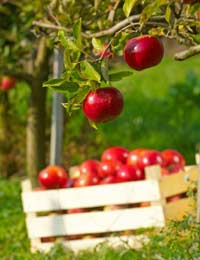Many UK gardeners are planning garden orchards to provide them with a fruit harvest and attract wildlife to their garden. Our guide to planning and designing orchards will help you get started growing fruit at home.

For many years, orchards have been torn up for housing or more intensive forms of cultivation. Recently though, garden orchards have made a comeback for three reasons:
- People are beginning to recognise the role of fruit trees in maintaining biodiversity and wildlife corridors.
- The economic crisis in 2008 caused many to wish to grow some of their own food. Gardening in general has become more popular again as a result.
- Community gardening has become popular, so community orchards are being created on allotment sites, in parks and other public places.
Jump To...
Why Create an Orchard in Your Garden?
Fruit trees can be beautiful, relatively long-lived and hardy, and very practical. You’ll be rewarded with a fruit harvest in Autumn, which you can store or preserve to enjoy fruit throughout the winter months.
It’s important to remember that an orchard requires maintenance. Trees need large planting holes to be dug and must be staked when planted (often in the depths of winter). They must also be pruned and checked for disease or damage. Above all fruit must be harvested and the produce that is collected has to be eaten, or storedfor later use.
Fruit Tree Orchard Design & Layout
In temperate, non-tropical regions, garden orchards were traditionally placed near bodies of water to try and limit exposure to frost. Fruit trees were laid out in a rectangular grid-like formation adapted from the designs used in medieval monasteries. These were, in turn, an interpretation of heavenly gardens as seen in the Books of Hours (prayer books).
Having grass or bare soil under the trees is a classic feature which allows easy maintenance. This creates space for pruning, treating for insects, and fruit collection.
Modern Orchard Layouts
There are two forms of modern orchard garden. The permaculture garden, often seen on allotments and organic farms, and the multipurpose orchard.
Permaculture Orchards
Creating a permaculture orchard means choosing a blend of food trees and other trees that have value for many purposes. The value lies not just in food production, but in the provision of other resources. For example, lilac trees may be used to attract pollinators, harvest blossom, and to make toiletries using flowers. Although it is not a traditional orchard tree it has great value in an permaculture orchard.
Underneath these non-fruiting trees it is usual to plant flowers or crops that can be harvested. So a lilac may have an under-planting of spring bulbs to look pretty. It may also have edible flowers such as nasturtiums, or the planting may be a low-growing shrub like a cranberry bush. This provides a crop, or an annual grass like millet offering winter seed to birds that are valuable to the orchard. In a permaculture orchard, every centimetre of space will be utilised. This includes walls and fences which support espaliered fruit trees, vines or blackberries. A permaculture orchard often has beehives to add to the productivity of the space.
Multipurpose Orchards
The classic monastic pattern of garden orchard design has become the starting point for many different styles of orchard gardening. This includes hexagon layouts with a central barbecue, summer house, table or paved area. Also popular, is the ‘walking orchard’. This is a rectangular space with trees along each side, providing open ground in the middle for other purposes.
Combining the practical and the pretty with the lifestyle of the owner can create orchard gardens that will have decades of life. They may feature a design that allows for less mobility in later life, or for a treehouse to be built for future children or grandchildren!
Best Orchard Soil Conditions
Orchards can be created in most soils. However, where there is heavy clay, some soil remediation at depth will be needed to stop waterlogging. These soil conditions can kill trees at the root.
Sandy soil can also present a problem. This is especially the case with larger trees which can develop root rock. This can often be resolved by building good walls or fences around the orchard in the traditional fashion.
Choosing Trees and Fruit For Your Orchard
- It’s vital when designing an orchard garden to ensure you plant varieties you are going to enjoy eating. There’s not a lot of point investing in a tree that you won’t love.
- Focus on disease-resistant varieties. It’s devastating to plan a garden that is damaged by blight or fungus or an insect that consumes your crop.
- Pollinators are important. Some fruit trees, and almost all bushes, are self-fertile. You may need to buy trees that share the same pollination period if you can’t work out if you have the right insects in your garden.
- The National Fruit Collection at Brogdale in the UK is a world-renowned resource that keeps many varieties of rare, old or specialised fruit. Some can be particularly suited to unusual conditions such as urban areas, wet soil or windy sites. They offer an advisory service for both buying and planning.
- If you’re planning a permaculture garden, design the under-planting so that the tree’s canopy does not interfere with the growth pattern of the shrub or flowers underneath.

